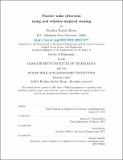Passive wake detection using seal whisker-inspired sensing
Author(s)
Beem, Heather Rachel
DownloadFull printable version (89.85Mb)
Other Contributors
Woods Hole Oceanographic Institution.
Advisor
Michael S. Triantafyllou.
Terms of use
Metadata
Show full item recordAbstract
This thesis is motivated by a series of biological experiments that display the harbor seal's extraordinary ability to track the wake of an object several seconds after it has swum by. They do so despite having auditory and visual cues blocked, pointing to use of their whiskers as sensors of minute water movements. In this work, I elucidate the basic uid mechanisms that seals may employ to accomplish this detection. Key are the unique ow-induced vibration properties resulting from the geometry of the harbor seal whisker, which is undulatory and elliptical in cross-section. First, the vortex-induced vibration (VIV) characteristics of the whisker geometry are tested. Direct force measurements and ow visualizations on a rigid whisker model undergoing a range of 1-D imposed oscillations show that the geometry passively reduces VIV (factor of > 10), despite contributions from eective added mass and damping. Next, a biomimetic whisker sensor is designed and fabricated. The rigid whisker model is mounted on a four-armed flexure, allowing it to freely vibrate in both in-line and crossflow directions. Strain gauges on the flexure measure deflections at the base. Finally, this device is tested in a simplified version of the sh wake { seal whisker interaction scenario. The whisker is towed behind an upstream cylinder with larger diameter. Whereas in open water the whisker exhibits very low vibration when its long axis is aligned with the incoming ow, once it enters the wake it oscillates with large amplitude and its frequency coincides with the Strouhal frequency of the upstream cylinder. This makes the detection of an upstream wake as well as an estimation of the size of the wake-generating body possible. A slaloming motion among the wake vortices causes the whisker to oscillate in this manner. The same mechanism has been previously observed in energy-extracting foils and trout actively swimming behind bluff cylinders in a stream.
Description
Thesis (Ph. D.)--Joint Program in Applied Ocean Science and Engineering (Massachusetts Institute of Technology, Department of Mechanical Engineering; and the Woods Hole Oceanographic Institution), 2015 This electronic version was submitted by the student author. The certified thesis is available in the Institute Archives and Special Collections. Cataloged from student-submitted PDF version of thesis. Includes bibliographical references (pages 183-193).
Date issued
2015Department
Joint Program in Applied Ocean Physics and Engineering; Woods Hole Oceanographic Institution; Massachusetts Institute of Technology. Department of Mechanical EngineeringPublisher
Massachusetts Institute of Technology
Keywords
Joint Program in Applied Ocean Science and Engineering., Mechanical Engineering., Woods Hole Oceanographic Institution.